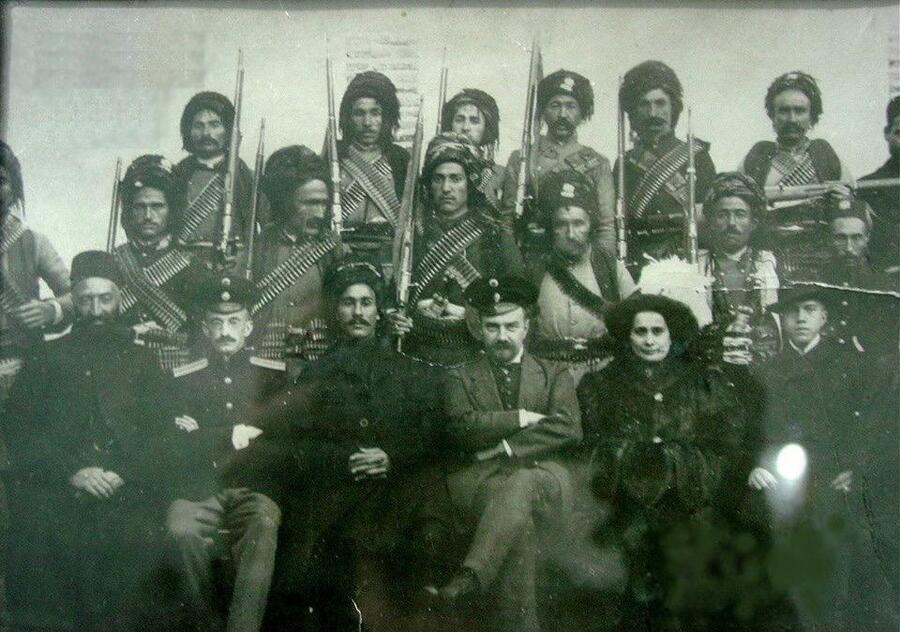Simail Agha Shikak (Simko Shikak), known as Sardar Nusrat, was born in 1266 in the Cheharik village of Salmas City in the East part of Kurdistan.
He was the son of Muhammad Agha and the descendant of Alikhan Shikak. From his childhood, he was a fan of the Kurdish movement and he grew the idea of Kurdish independence in his mind. From a young age, he began to collect Kurdish cavalry and fighters. Simail Agha's armed activities first was limited to the eastern part of Kurdistan but later it was spread to the southern part of Kurdistan, too which was then under the Ottoman's rule.
During World War I and years after that, the most well-known figure on the Iranian-Ottoman border was Simail Agha (Simko), the leader of the Shikak clan. He cleverly took advantage of the opportunities afforded to the complexities of the region in the first quarter of the 20th century, maintaining his balanced position between the Ottomans, Russians, Iranians, and the British, by having a connection with all of them and developing his power and influence in the region.
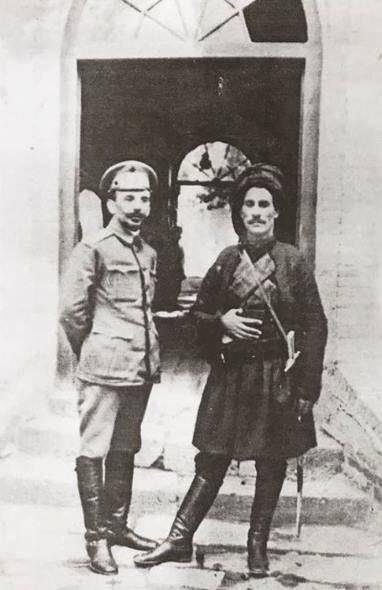
After WWI, he presented himself as an independent ruler, cooperating with a group of Kurdish national leaders and confronting the central government with problems. Even when the Iranian Army in August 1922, based on their own words, provoked his problem and made him leave Iran, he remained a strong player in central Kurdistan, and the British and the Ottomans both wanted to get closer to him for their interest to use his power and charisma among the Kurds to solve the Mosul issue.
In the Constitutional Revolution in Iran, Simko joined the forces of "Iqbalu Saltana", the ruler of Mako. Then he became the ruler of Qutur and his power was approved by the government.
Since 1913, Simko developed strong ties with the Kurdish national leaders and he approved their discourse. He also married Seyyed Taha's sister, the successor of Sheikh Obeidullah Nahri. This made his position even stronger.
On the other hand, Simail Agha also had a relationship with Abdulrazaq Badrkhan, one of the Emirs in Botan.
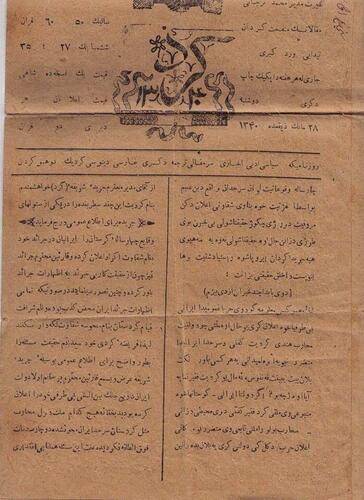
During WWI, Simko protected himself from war and organized his forces and as the sources say, he kept all the windows to various opportunities open. Simail Agha wanted to watch the regional and global policies of the European forces carefully, and also make the Kurdish and Iranian situation move towards a balanced situation. The changes were so complicated that all political activists in the region were confused.
After the Russian Revolution, when General Baratov's army withdrew from Kurdistan, Simko was able to take control of most of the areas, weaponry, and artilleries left.
After World War I, the Ottomans left Azerbaijan and a strong government was not established in Azerbaijan thus the only effective power and position in the region belonged to Simko Shikak. Apart from his forces, hundreds of Ottoman soldiers were with him and supported him.
In February 1919, a meeting was held among the greatest Emirs in the East part of Kurdistan. At this meeting, a general uprising against the Iranian government was discussed. However, they were determined not to do anything until the great governments declared their agreement and supported the changes.
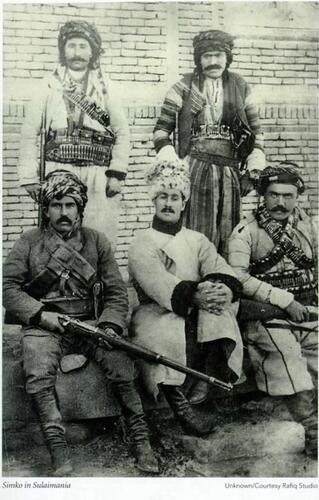
After that, Simko did not wait for the uprising of the other Emirs of Kurdistan and he seized the cities of "Dilaman" and "Khoy". Then he besieged the great city of Urmia. A part of the Azeri people of Lakistan, i.e., the northwest part of Dilaman did not agree to his rule so he attacked and broke their forces and made them retreat to "Sharaf Khan port". The northern areas of Urmia Lake also fell under Simko's control.
At that time, the new governor of Tabriz, "Sardar Entesar", attacked Simko forces with a great army and withdrew them. As a result, Simko negotiated and agreed with the commander of the Cossack forces, "Philipov", who had attacked them on behalf of Tabriz.
This agreement made Simail Agha's position even stronger. In 1920, once again he captured the plains of Urmia, Salmas, and Khoy and he appointed a ruler for Urmia himself. From that time on, Simko's forces grew larger.
On his last attack on the Iranian forces, the number of his fighters reached ten thousand soldiers.
In 1920, Simko held several meetings among the Kurdish lords in Azerbaijan. In the summer of 1921, the region of Simko's authority included the west of Urmia Lake, Banah, Sardasht, and the northwestern corners of Iraq. In addition to the tribe of Shikak, other tribes such as Harki, Mamash, Mangur, Debukri, Piran, Zarza, Gawirk, Faizulabaigi, Pishdar, and the small tribes of Banah united with Simko.
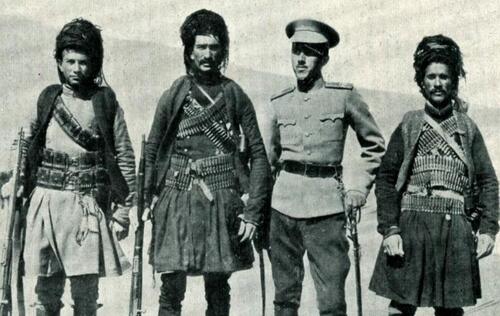
It is worth mentioning that Simko also took the city of Sablagh from the control of the State forces and in this war, a part of this city was looted which led to the Kurdish nationalists' criticizing Simko. He never accepted this claim and he justified it later. He said that the forces of the regime took the fight into the streets and alleys of the city and I was not able to stop my forces' reactions.
However, after this, he left Sablagh and left it for Hamza Agha. After this attack and victories of Simail Agha and his 10000-man army, non-Kurdish people also acknowledged his authority, and the people and rulers of the cities of "Miandoab", "Maraghe", and "Bonab" sent letters of surrender to Sablagh.
Simko's victories turned him into a great figure. In July 1922, the region under Simko's control grew much larger. From the East part of Kurdistan, his authority stretched to "Shahin dej" and "Saqqez", from the north it reached "Qutur" and even in the area of Marivan and Hawraman. Some of the southern tribes in Lorestan were ready to revolt with the support of Simail Agha.
At that point, Iran was in a critical situation from all parts. From the north, the forces of Mirza Kouchak Khan Jangali began to revolt. On the other hand, a man named "Khalo Qurban" from Harsin in Poshtkouh collected the nomads' forces against the central government.
Reza Khan tried to make allies from the other tribes to unite them against Simail Khan Simko.
Mirza Kouchak Khan who had hidden relationships with Simko and was a fierce opponent of the central government, continued his struggle; Khalo Qurban however, united with Reza Khan forces. He also kept his relationship with Mirza Kouchak Khan. He finally killed Mirza Kouchak Khan and brought his head back to Reza Khan.
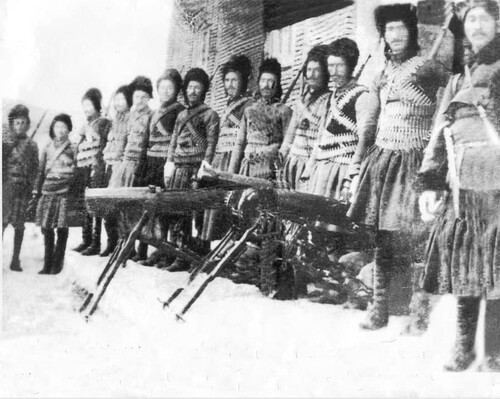
After this incident, Reza Khan sent Khalo Qurban with a large number of armed forces to attack Simko. In 1921_ 1922 Khalo Qurban formed an army of the nomads' forces and attacked Simail Agha's army. After hearing about this, Simail Agha collected a large army and attacked Khalo Qurban's forces, defeated them badly, and made them withdraw.
When Reza Khan was not successful in defeating Simail Agha's army and the Kurdish forces in war, and on the other hand he was under political pressure from the Iranian nationalists, he tried to beat Simail Agha in another way. Therefore, he asked to meet with Simko and solve the problems through dialogue.
That is why in 1930, Reza Khan invited Simail Agha to Shino (Oshnaviye) to negotiate. Simko went to Shino as a diplomat to meet Reza Khan himself; however, after being kept waiting for two days as the state's forces' guest on the third day, Colonel Sadiq Khan, the representative of Reza Khan, greeted Simko. When they said their farewell, the colonel ordered them to shoot Simko and his delegation from behind. They all got killed except for two people. The assassination of Simail Agha is a dark spot for the Iranian central government which had called a political guest for negotiation while they killed him in an inhumane and non-diplomatic way. This was the end of Simail Agha Simko's revolution and the rule of Shikak.

